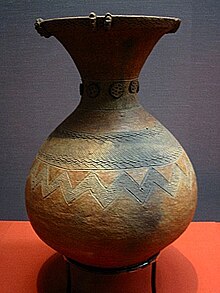Yayoi pottery (

History
editDistinguishing characteristics of the Yayoi period include the appearance of new pottery styles that distinguishes it from the earlier Jōmon pottery. A point of difference is evident in the way Yayoi pottery is technically superior but artistically less advanced due to the way Jōmon pottery featured greater freedom of design and more variety of shape.[3][4][5] It was followed by the Haji pottery of the Kofun period.
There are accounts that cited a relationship between Yayoi pottery and the pseudo-Korean-style Late Mumun pottery.[6] This link is said to be based on hybridization or imitation and demonstrated in the case of the hybrid style of pottery produced in the Neug-To Islands.[6]
References
edit- ^ Keally, Charles T. (2006-06-03). "Yayoi Culture". Japanese Archaeology. Charles T. Keally. Retrieved 2010-03-19.
- ^ Imamura, Keiji (1996). Prehistoric Japan: New Perspectives on Insular East Asia. Honolulu: University of Hawaii Press. p. 13. ISBN 0824818539.
- ^ Sansom, Sir George Bailey (1978). Japan: A Short Cultural History. Stanford, CA: Stanford University Press. p. 2. ISBN 0804709521.
- ^ "Yayoi ware - Japanese earthenware".
- ^ The Nakano-shi Board of Education (1999). "
中野 市 の弥生 土器 ". Comprehensive Database of Archaeological Site Reports in Japan. Retrieved 2016-09-01. - ^ a b Matsumoto, Naoko; Bessho, Hidetaka; Tomii, Makoto (2016). Coexistence and Cultural Transmission in East Asia. Oxon: Routledge. p. 271. ISBN 9781598743357.
External links
editMedia related to Yayoi pottery at Wikimedia Commons
- Comprehensive Database of Archaeological Site Reports in Japan, Nara National Research Institute for Cultural Properties